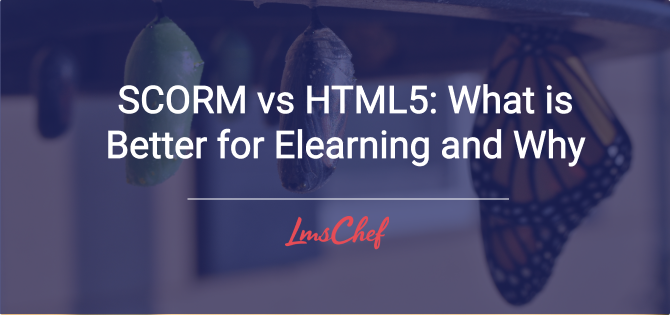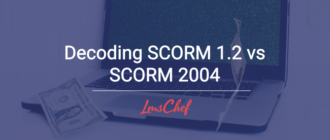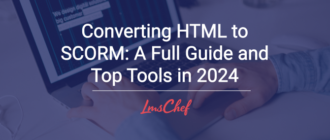When it comes to delivering online learning content, there are two popular options: SCORM and HTML5. Both have their own strengths and weaknesses, but which one is better for your learning management system? In this article, we will compare SCORM and HTML5 and discuss why HTML5 may be a better choice for organizations looking to create engaging and visually appealing courses. We will explore the benefits of HTML5, such as its compatibility, user engagement, and cost-effectiveness, and explain why it can help deliver high-quality online learning experiences. So, let’s dive in and explore the world of SCORM vs HTML5.
What is SCORM?
SCORM stands for Sharable Content Object Reference Model. It is a set of technical standards that allows e-learning content to be delivered and tracked across different learning management systems (LMS). SCORM is widely used in the e-learning industry and is supported by most LMS platforms.
Benefits of SCORM
- Compatibility: SCORM is compatible with most LMS platforms, making it easy to deliver and track content across different systems.
- Interactivity: SCORM allows for interactive content, such as quizzes and simulations, to be delivered and tracked.
- Tracking and Reporting: SCORM allows for detailed tracking and reporting of user progress and completion rates.
- Reusable Content: SCORM content can be easily reused and repurposed for different courses and platforms.
Drawbacks of SCORM
- Limited Customization: SCORM content is limited in terms of customization and may not allow for advanced features or design elements.
- Complexity: SCORM can be complex to implement and may require technical expertise.
- Compatibility Issues: While SCORM is widely used, there may be compatibility issues with certain LMS platforms or older versions of SCORM.
What is HTML5?
HTML5 is the latest version of the Hypertext Markup Language, used for creating and structuring content on the web. It is a popular choice for delivering e-learning content due to its compatibility with different devices and browsers.
Benefits of HTML5
- Compatibility: HTML5 is compatible with most devices and browsers, making it easy to deliver content to a wide audience.
- User Engagement: The format allows for interactive and engaging content, such as animations and videos, to be delivered.
- Responsive Design: HTML content can be designed to be responsive, meaning it will adapt to different screen sizes and devices.
- Customization: HTML5 allows for more customization and advanced features compared to SCORM.
Drawbacks of HTML5
- Limited Tracking and Reporting: HTML does not have built-in tracking and reporting capabilities, so this must be implemented separately.
- Lack of Standardization: Unlike SCORM, there is no standardization for HTML5 content, meaning it may not be compatible with all LMS platforms.
- Technical Expertise Required: Creating HTML5 content may require technical expertise or the use of authoring tools.
SCORM vs HTML5: A Comparison
Content Delivery
SCORM and HTML5 both allow for the delivery of interactive and engaging content. However, SCORM has built-in tracking and reporting capabilities, while HTML5 does not. This means that SCORM is better suited for tracking user progress and completion rates, while HTML format may require additional tools or plugins for this functionality.
User Engagement
Both SCORM and HTML5 allow for interactive and engaging content, but HTML5 may offer more options for customization and advanced features. This can lead to a more engaging learning experience for users, which can improve retention and overall satisfaction with the course.
Learning Management
SCORM is widely supported by most LMS platforms, making it easy to deliver and track content across different systems. HTML5, on the other hand, may not be compatible with all LMS platforms, which can limit its use for some organizations. However, HTML5’s compatibility with different devices and browsers can make it a more versatile option for delivering content to a wider audience.
Course Development
SCORM content is limited in terms of customization and may not allow for advanced features or design elements. HTML5, on the other hand, allows for more customization and advanced features, making it a better choice for organizations that want to create visually appealing and interactive courses.
Why SCORM May Be a Better Choice
SCORM and HTML5 both have their own strengths and weaknesses, and the choice between them depends on the specific needs and goals of an organization. However, there are a few reasons why some organizations may prefer SCORM over HTML5:
- Built-in Tracking and Reporting: SCORM has built-in tracking and reporting capabilities, which makes it easier to monitor user progress and completion rates. This can be particularly useful for organizations that require detailed tracking and reporting for compliance or assessment purposes.
- Widely Supported by LMS Platforms: SCORM is widely supported by most Learning Management System (LMS) platforms. This means that organizations using SCORM can easily deliver and track content across different systems without compatibility issues.
- Reusability of Content: SCORM content can be easily reused and repurposed for different courses and platforms. This can save time and effort in content development, especially for organizations that have a large library of existing SCORM content.
It’s important to note that while SCORM may have these advantages, HTML5 also has its own benefits, such as compatibility with different devices and browsers, user engagement through interactive and engaging content, and customization options. Ultimately, the choice between SCORM and HTML5 should be based on the specific requirements and preferences of the organization.
Conclusion
In conclusion, both SCORM and HTML5 have their own strengths and weaknesses. SCORM format can be better for organizations that need better tracking and reporting tools both with LMS compliance, while HTML5 may be a better choice for organizations looking to create more engaging and visually appealing courses. Consider your organization’s needs and goals when deciding between SCORM and HTML5 for your course development.







